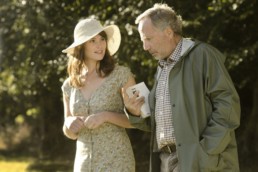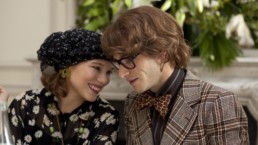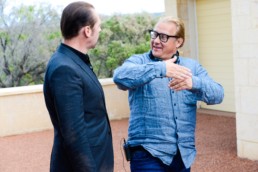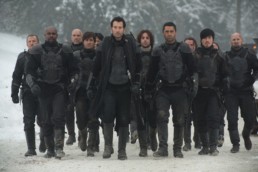Results: 'Gemma Bovery'
The concept of art reflecting life is a very simple one to grasp, an artist is living and creates something that is influenced by their life. Simple. A more difficult idea to contemplate is the idea of life reflecting art, a more subjective perspective that relates different social understandings and the influence of the art surrounding the understanding.
Director Anne Fontaine attempts to rein in this abstraction in her film adaptation of Posy Simmonds’ graphic novel, Gemma Bovery. When an aged French baker (Fabrice Luchini) discovers his new neighbors (Gemma Arterton and Jason Flemyng) carry the same name and traits of famous writer Gustave Flaubert’s characters, Gemma and Charles Bovery, he becomes obsessed with this living and breathing manifestation of literary art. This sets him and the audience on a path of adultery, betrayal, and eventual death, all with the beautifully quaint, rural Norman village serving as a backdrop, in a way becoming more than just a setting.
Sometimes the beauty of the French countryside can be overwhelming and draw away from the focus of the storyline. Or on the other hand, it can be a shame if the cinematographer foregoes taking advantage of such an incredible setting. Cinematographer Christophe Beaucarne does an excellent job of establishing and using this idyllic setting without its beauty and romantic potency becoming too overwhelming. He maintains a subtly well-lit and poetically simplistic aesthetic that contrasts the living literature that it possesses to vibrant showey-ness of the modern world seen in Bovery’s contemporary fashion inclined friends, Wizzy and Rankin (Elsa Zylberstein and Pip Torrens).
While this basic theme of feminism is maintained, the film itself doesn’t carry the message as well as perhaps the graphic novel was able to.
Continuing to analyze the aesthetic, it is very clear that this film is not your typical graphic novel adaptation. There are no drastic angles and dramatized lines and shadows. The original illustrations of the Simmond’s work deal with soft lines and a semi-minimalist sketching style similar to Tin Tin or Calvin and Hobbes. The quirkiness that is associated with this style, however, seems to be lost in its translation to film. This is unfortunate as there are moments throughout the film, mostly in the middle hour, which could have benefitted from a little more quirkiness or humor. Despite superb performances from the entire cast, especially Luchini and Arterton, the film seems to drag on even with exciting plot points; for whatever reason, the film runs slow.
But the biggest criticism, as is with most adaptations, is its failure to reach its true potential. As the graphic novel is a feminist commentary, one would expect that the film is also a feminist film. Gemma Bovery is a complicated woman living her life and Martin Joubert (Luchini) is a foolish man, with a literary god-complex who, in his attempts to save Gemma from her impending doom, ends up killing the woman he has assigned himself the responsibility to protect. While this basic theme of feminism is maintained, the film itself doesn’t carry the message as well as, perhaps, the graphic novel was able to. The film is told from the perspective of Joubert, giving the audience a story seen solely from the male gaze, thus distorting a sense of truth that could have possibly been achieved with a third person narrative style and camera work. This is something that isn’t an issue in the particular graphic novel style because the drawings are often already in the third person.
Perhaps due to the film's singular perspective, it becomes very difficult to connect with Gemma as she partakes in her adulterous relationships. Although one could argue the first incident was a result of incidentally strong influence from Joubert, Gemma becomes increasingly dislikeable and her choices become harder and harder to understand. She falls for men quickly and seems to float through her small French sexual wonderland just before her attempt at redemption. By the time she eventually shows signs of regret, it seems a little too late for viewers to really care about Gemma’s fate and that is never the end goal for a filmmaker’s title character. The film could have benefitted from a shorter runtime, but one thing's for sure– this film is probably the cheapest way to enjoy the French countryside.
Gemma Bovery opens at The Landmark in West L.A., Pasadena Playhouse 7 in Pasadena, and Town Center 5 in Encino on Friday, May 29th.
https://www.youtube.com/watch?v=Tg_Jm5jRHGw
Review: 'Good Kill'
In Andrew Niccol’s Good Kill, audiences watch as military drone pilot, Major Thomas Egan (Ethan Hawke) struggles with the morality of being separated from the danger below as well as the ethical absence of his superior’s orders. He is tortured by his thoughts and guilt for his military obligation, and so he turns to alcohol and isolates himself from his wife (January Jones), family and friends. Probably the most interesting aspect of the film is the correlation of his self-destruction over being separate from the violence and his slow drift away from the world around him. However, it is a trait that seems to be a starting point for any contemporary war script.
The war film has been an exciting and popular genre for many years, and is one that grows and develops exponentially as the art of war changes. Following the Vietnam War, films began to steer away from the theme of battlefield glory seen in films such as Kelly’s Heroes or The Longest Day and towards a more analytical standpoint on the psyche of the individual soldier, such as in Apocalypse Now.
Recently, there has been a new shift that seemed to coincide with the United States involvement in Iraq and the Middle East. This shift in perspective is a combination of both of these war film philosophies. While focusing on the mind of the soldier being trapped in a war mentality, it seemingly glorifies the male protagonist for sacrificing his “American Dream Life” for this war machine. However in the case of Good Kill, as with many contemporary war films today, it seems to abandon any sense of responsibility or moral repercussions for Major Egan’s choice of war over family. In the end, he has driven his family away due to his damaged psyche and personal flaws leaving him completely alone, with the exception of an out-of-leftfield romantic interest, Airman Vera Suarez (Zoë Kravitz). However after all of this, his cinematic redemption is killing a rapist thousands of miles away, not dealing with any of these terrible developments on the home front. It is a similar type of perspective to Clint Eastwood’s American Sniper in that Chris Kyle (Bradley Cooper) is celebrated and then empathized with for leaving his family for the greater good. However this type of movie has a polarizing effect on American audiences, which makes sense in the huge variance in socio-political perspective of American society.
There are moments of great suspense, varying depths of depression and a brief sparkle of redemption.
But before this review turns into a discussion of the relationship between a nation’s philosophies and the war films it produces, let’s circle back to the film at hand. Good qualities of Good Kill: as to be expected, Ethan Hawke gives an excellent performance while breaking from his usual, like-able with an edge, type of character we tend to expect. His quiet and distant portrayal of Major Egan seems to be on point with the torn and damaged military archetype. Keeping up with Hawke, is the lovely January Jones. She, however, sticks to the acting chops that garnered her such well-deserved attention as the disgruntled and mistreated housewife in Mad Men, and portrays an excellent disgruntled and mistreated military house wife driving audiences to both despise her condescending tone and spoiled sensibility while still understanding her role in her despairing relationship.
Another point in the plus column, the film was nicely shot and had some very pleasing touches to its aesthetic. The visual similarity between the square, tan buildings that the drone crews are bombing and the square, tan containers that the drone crews work within, creates a visual representation of the connection that the drone operators feel with the bystanders that appear on their screens. This type of symbolism could overpower a scene and draw away from its suspense, however it is done with such subtlety that it sneaks its way in without audiences fully realizing its existence.
On the other side of the coin, there are parts that seemed to draw away from the storyline. Unfortunately, the biggest detractor from the film’s effect lies within the screenplay, and that is the repetition, the repetition, and the repetition. The film seemed to become a bit of a loop revolving from Egan going to work which he doesn’t want to do, killing something he didn’t want to, being told he can’t get back into a jet again which he wants to do, and then going home to be nagged… which he doesn’t want to do. Admittedly, one could argue that this is not redundancy but a very accurate representation of what life is like for a military drone pilot; the annoyance that audiences begin to feel is meant to be a way of connecting the viewer to Egan. However, it seems that Egan was gone before the film even began and so the connection becomes less of a possibility and the repetition becomes a less effective technique.
Good Kill may not be your most intrinsic of war films and because of its polarizing themes that come with a contemporary war plot, audiences will either love it or hate it with little possibility of finding one’s self in the middle. There are moments of great suspense, varying depths of depression and a brief sparkle of redemption. Sometimes that is all a person wants from a movie, and so this film will find its audience.
Good Kill opens in Los Angeles at the Arclight Hollywood this Friday.
https://www.youtube.com/watch?v=jO-qB8xjjk8
Gaspard Ulliel and Bertrand Bonello on 'Saint Laurent'
We speak exclusively to Gaspard Ulliel and Bertrand Bonello, star and director of the new film Saint Laurent, in theaters in NY and LA today.
For our review of the film, click here.
https://www.youtube.com/watch?v=0u-gr1_x7oY
Review: 'Saint Laurent'
When watching a film biopic, there are certain expectations of what information will be given to its viewers; A back-story, a rise, a fall, and often redemption form a narrative template that usually structures the cinematic story. This is the tried and true method that has become the norm of this Hollywood subgenre. Saint Laurent’s director, co-writer and musical score composer, Bertrand Bonello decides to throw away these requirements by turning a macro-story of a legendary man’s life into a tighter focused tale encompassing a window of 10 years in Yves Saint Laurent’s spectacular existence (with the exception of a few brief scenes that take place outside of this time frame).
This chronic boundary tightens focus on the period accredited with the beginning signs of the transformation of Yves Saint Laurent from an artist to a brand. And what a period that was, the film is coated in beautiful colors, people, and, of course, its fair amount of 1970s drug euphoria. The dance clubs, the parties, and the fashion are all captured in a vibrant Technicolor splendor and with the use of 35 mm film by cinematographer Joseé Deshaies, the cathartic effect of the textures and contours dominate the screen. There is absolutely no doubt that this film’s aesthetic maintains a homeostatic beauty throughout; something that is crucial in connecting the audience to its protagonist.
While it may not adhere to more standard Hollywood practices that may jar some audiences, it’s an art film about fashion… so it really shouldn’t come as much of a surprise.
This beauty does not contain itself to simple visuals but successfully bleeds into the relationship between Yves, his lover and his love for the time in which he has found himself. Gracefully executed by Gaspard Ulliel, Yves is shaped by his setting, just as much as he influences it, and his relationship with Jacques de Bascher (Louis Garrel) bares a strong impression of his existence. Bonello has commented that the character of Jacques de Bascher is in fact a manifestation of the opiate, live-hard philosophy of the 1970s. On the surface, he could in fact be replaced, but instead holds his importance in being that embodiment of Yves’s destruction. It makes so much sense, that with this in mind, Bonello creates such a passionate relationship between the genius and his destruction.
The ornate and fantastic atmosphere surrounding Yves is in sharp contrast to its central character. Gaspard Ulliel truly nails a quiet subtlety in his portrayal of genius without coming off as standoffish. He carries himself with a sort of bold fragility in that he can demand the attention of an entire room but moves as if being carried by a light breeze that came in with him. In his voice, there is a soft reed-like nature while still carrying a sense of carefully selected deliberation that is very much associated with the real-life Yves Saint Laurent.
The subtlety with precision is also reflected in Bonello’s choices for establishing certain aspects of Yves’ character on a larger scale. As mentioned before, Yves is not given a back-story on-screen because the film drops the audience into his already thriving career. To portray his character’s fame and pronounced greatness, Bonello creates a fictitious letter from Andy Warhol that explains that he and Yves are two of the last legends in pop culture. With out any stress, and probably in the least expensive way possible, a background has been given and viewers accept it.
In a similar fashion, Bonello conveys in a single scene of Yves giving a makeover to Mme Duzer (Valeria Bruni Tedeschi), Yves Saint Laurent’s influence on women in society. Bonello explains, “A man manipulates a woman who is suddenly transformed before our eyes. Valeria is brilliant in that scene. In her performance, she becomes 15 years younger in three minutes.” After being touched by the Midas hand of fashion, the tired woman has become empowered and confident, acting as a symbol for Yves larger global effect.
Bonello’s Saint Laurent is a beautiful film on multiple levels. It tells a story of man’s transformation with sophistication and style that should be the main expectation of the story of Yves Saint Laurent. While it may not adhere to more standard Hollywood practices that may jar some audiences, it’s an art film about fashion… so it really shouldn’t come as much of a surprise.
Saint Laurent is in theaters this Friday, May 8th.
https://www.youtube.com/watch?v=lvnePG2VWDE
Luke Hemsworth and Alice Braga on 'Kill Me Three Times'
Luke Hemsworth, relative newcomer to the big screen (but thanks to brothers Liam and Chris, his last name isn't) along with Alice Braga, best known for her role as 'Anna' in I am Legend, sat down to speak with Ryan Denman at a round table interview at the Four Seasons Hotel Beverly Hills. With their respective Australian and Brazilian accents, it's easy to see why the new film they star in, the Simon Pegg-led Kill Me Three Times, succeeds as a multicultural blend of action thrills set against a beautiful West Coast Australian backdrop. There's no lack of humor and pride from the charismatic and charming Hemsworth and Braga, whose genuineness is fully apparent from the first question asked. We begin:
Shooting in Australia must have been a great treat.
Luke Hemsworth: I heard it described once like, "Sex without a condom is the same, but just a little bit better." Acting in your own country, in your own accent is like that.
Laughter
Alice Braga: It was a fun type of film to make because it is a comedy, but not just a comedy; action, but not just action. It's always fun to participate in films that go down that type of road and being in Australia for me was a blessing. Brazilians are a lot like Australians, very alive and warm and kind and happy and I felt at home there. Everyone including the cast and crew brought that image to the film and it was fun!
Did you experience any culture shock?
Alice Braga: Oh my God, the way that they drink! Do not go with Australians to a bar– and I know how to drink, I'm Brazilian. When they get drunk with the accent is like, "What?"
Luke Hemsworth: I'm not going to say anything...
For our review of Kill Me Three Times, click here.
Luke, what are you the most proud of about your country?
Luke Hemsworth: Going to the place where it was filmed was pretty special for me because I had been to the West coast, but had never been down South of the West coast where we shot, which is one of the most amazingly pristine, wildly rugged parts of the world. There is no one there for starters, and you've got huge waves, huge sharks, amazing surf.
Is this near Perth?
Luke Hemsworth: It's about three hours south of Perth. The Margaret River region, which is an incredible wine making region, is a huge added bonus to shooting the film [where we did]. We actually got to surf in the film too. It never made it into the final film, but we got paid for two days to go surfing.
Do not go with Australians to a bar– and I know how to drink, I'm Brazilian. When they get drunk with the accent is like, "What?"
In the film your characters look like they got beaten up a lot, what was it like filming those brutal scenes?
Alice Braga: Well my character is beaten up a lot so yeah, I got some scratches. Not that bad though. My stunt girl was amazing, she was the one that rolled down the hill. I did try a lot [with the stunts] but it's hard, there's so much that happens with that character. I remember when I met the stunt girl and I said, "Good luck because everyone is trying to kill you."
Luke Hemsworth: As a performer you want to do as much as you can, but there is a point you reach where everyone's like, "Nah, we're going to have the stunt guy do this." Then there's this point you reach when it's actually starting to hurt so yeah, the stunt guy can do it.
You look very athletic, how did you prepare physically for the role?
Luke Hemsworth: Sports has always been a huge part of my life, it kind of always went hand in hand with acting. I've played Australian football, water polo, and have been kickboxing for a long time.
Are there any disciplines in athetics that you transfer to acting?
Luke Hemsworth: You know what it is, I think it's failure. So many athletes overcome or are faced with failure over and over again and there is such a marriage with acting in terms of that. There is so much failure that goes along with your journey as an actor before things get a little bit easier. You learn to deal with failure one way or another... In acting you are challenged both professionally and creatively, and in sports you're definitely challenged professionally, and you fail so much more than you ever succeed.

How did these characters resonate with you when you first read the script?
Alice Braga: It's funny because I got offered the part much earlier than everybody else because the producer is my agent's brother. So he sent me the script and I liked it, then after a change in directors they hired Kriv Stenders. I was always curious how they were going to make this film with the mix of being witty, having comedy, drama, violence and action. I thought it was an interesting challenge to play this girl.
Luke Hemsworth: Also the fact that you get to work, there are things that you have to do to grow as a person and a performer. You look for things [in characters] that relate to you that is a bonus, and there are things that aren't attractive as well, but the bonuses always outweigh the negatives. You never want one note in a performance, so it was an easy film to say yes to.
How responsible do you feel as actors to create the tone of the film?
Alice Braga: I feel like the best answer for that question is Simon Pegg. Simon is such a brilliant actor and such a smart, intelligent and generous person, and I think he brought that tone. I think a lot of what the film became is because of Simon. As soon as he got cast I was really excited. I think it was a challenge for Kriv as well, playing with all of those sides without being too much one thing or another. Finding the right editor to put together all the stories and find the pace the film as well.
Luke Hemsworth: Right at the start, he set the tone of the film for everyone else. No one is playing with him, but there's an element of, "Ok, this is the meat of the film and this is where everyone else needs to sit." It makes it just a little bit easier.
For our interview with Simon Pegg and director Kriv Stenders, click here.
Is this type of film the direction you see yourselves going in for future projects?
Luke Hemsworth: Yeah part of the attraction of acting to me is that you get to do different things. There are elements of that genre and story that are great and attractive but in a lot of ways, that's done. What challenges me in another aspect is the core of acting. You don't have to do the same thing over and over again and it's always a strange battle because everyone wants to put you in a box, whereas good actors try to fight that. They want to do stuff that is challenging and different.
Simon Pegg and Kriv Stenders on 'Kill Me Three Times'
Simon Pegg might just be the ultimate survivor; having survived zombie attacks in Edgar Wright's cult-smash Shaun of the Dead, international espionage alongside Tom Cruise in Mission: Impossible - Ghost Protocol, and alien-takeover as Scotty in the newest Star Trek reboot, he's no stranger to his own self-danger, which director Kriv Stenders knows too well. That's why seeing Pegg as the mostly aloof end-of-the-day hero works so well as the lead-billed star in Stenders' new black comedy thriller, Kill Me Three Times. We recently had the chance to sit down with Mr. Pegg and Stenders, who talked at length about the film.
YOUR CHARACTER IS SO MULTIDIMENSIONAL, HOW DID YOU PREPARE FOR THAT ROLE?
SIMON PEGG: Well, I spent some time killing people for a living... ha! No it was all on the page for this film, it was right there. The joy of this [script] was reading it and thinking, "Oh I could so play this character." It was a gift in terms of characters and not being a regular, nice chap which I often play. It was an amoral, kind of suave guys and I felt like this was going to be fun.
WHAT RESONATED WITH YOU GUYS IN TERMS OF WHAT THIS STORY IS ABOUT AND WHAT YOU COULD BRING TO IT DIRECTORIALLY OR AS AN ACTOR?
KRIV STENDERS: It was such a fun read, when I first read the script it really leapt off the page and it's one of those rare screenplays that you can "see" it as you read it, and I loved the engineering of it. It was very cleverly constructed and written. For a filmmaker who loves movies, it was a gift. I love those kinds of films that have a really great conceptual engine, and the minute I read it I knew I had to do it. When Simon came onboard, the die was cast; we really knew what kind of beast we were making.
YEAH LUKE [HEMSWORTH] AND ALICE [BRAGA] WERE SAYING WHEN YOU CAME ONBOARD, THEY IMMEDIATELY KNEW THE TONE OF THE MOVIE.
SP: Haha, I don't consider myself a comedian– I was a comedian a long time ago but I'm an actor now and dammit I want to be taken seriously.
(Laughter)
But I think people who are known for comedy work well as villains because it provides a sort of extra textural edge of like-ability. Evil is not funny, evil is horrible, so to soften it slightly with a degree of humor makes it something you can enjoy and take pleasure in. That's to our amusement; we walk into this beautiful Western Australian town and we see the utter shambles of a community, all backstabbing, fighting, and betraying each other, and with Charlie– the bad guy– we all go, "Oh my god what a sh*t show." It was fun to play that.
HOW WAS IT SHOOTING A GUN?
SP: It's cool in a "movie" sense.
(Laughter)
The thing about this film that I really like is that it is violent, but it's a theatrical violence. It's hyper-real, it's not nasty real violence. You should never lose sight of the fact that violence is never a good thing, but for entertainment purposes, there is a degree of enjoyment.
IT SEEMS FARCICAL IN A WAY.
SP: Yeah, the whole film is just a catalogue of errors made by these very inept people, into which walks this very professional, super-professional, man who finds it all incredible annoying.
HOW MANY CIGARETTES DID YOU HAVE TO SMOKE?
SP: Haha I don't know, that's a really good question! I've never been asked that before. They were not real, it was a lovely herbal blend. Not that kind of herbal blend. We'd get nothing done. I'd just be at craft services all day!
(Laughter)
No, they were these stinking edible cigarettes. I used to be a smoker so hopefully I could portray Charlie's chain smoking nonchalance with some authenticity. If they had been real, no, that would have been it. I would have been back on them.
IN YOUR PREVIOUS WORK YOU'VE OFTEN HAD WRITING CREDITS, HOW DOES IT COMPARE TO WORKING ON A FILM AS AN ACTOR?
SP: I really like writing and being a part of what I write, but sometimes it's nice to read a script and not need to do anything. Then you can just have fun acting. It's nice, it's like a holiday sometimes, when you have enough faith in the script and just let go. I especially love the way it plays with the audience's perception of what's happening, information is given in increments so you think one thing is happening and then there is a twist... I really like that playfulness. It would be really conceited on me to think I could doctor every script I get.
WHAT WAS IT LIKE SHOOTING IN AUSTRALIA?
KS: In Australia we have a very small industry, but for a small country we make a lot of movies but we're also limited because budgets are smaller and it is hard to make films for the international stage. This was a great opportunity to make an Australian film with an Australian cast and some international cast, therefore it wasn't a film struggling to get out of its origins. I said to the crew to think of this film like an American movie that just happens to be shot in Australia. Alice was on the project before I came on, and when I knew she was attached I thought it was lovely idea. Sometimes you'll cast an American in an Australian role and it feels wrong because you can see it's a cynical thing to make the film more commercial.
SP: I think it felt right to have Charlie be British because he is literally from the other side of the planet, he's an alien in this town. He looks like it, he sounds like it, and it was really nice to play him being literally from being from the other side of the world. It all added to his mystic.
SIMON, IF YOU COULD FILM A MOVIE ANYWHERE ELSE IN THE WORLD, WHERE WOULD IT BE?
SP: Ah, that's one of the best things about this job: traveling. I've been to many places, but I'd love to shoot in Italy. I've never been to Italy.
ONE OF MY FAVORITE THINGS ABOUT THE FILM IS THAT IT SEEMS TO CHALLENGE TRADITIONAL GENDER ROLES, IS THIS SOMETHING YOU HAD IN THIS FILM PURELY FOR COMEDIC PURPOSES?
KS: A lot of it was inherent in the screenplay. What I love about this film is that it is a genre film, essentially a thriller or a noir thriller. Noir thrillers have tropes that everyone expects and that's the great thing about genre films, it's all right to use these tropes, it's just how you spin them. We weren't making a realist, kitchen-sink drama, we were making a fun movie and I loved that I could play with those stereotypes.
YOU ARE SO FILM LITERATE, DO YOU EVER TAKE INSPIRATION FROM PERFORMANCES OR CHARACTERS THAT YOU'VE SEEN IN OTHER MOVIES?
SP: All the time, you draw on what's gone on before. There are certain great performances that stay in your mind you might subconsciously channel.
DOES CHARLIE END UP LIVING PAST THE FILM, IN YOUR MIND?
SP: Oh absolutely! I'm fully expecting "Kill Me Four Times."
'Kill Me Three Times' opens at the Nuart Theatre this Friday.
Review: 'Kill Me Three Times'
Kriv Stender’s Kill Me Three Times is a very interesting take on the classic botched murder storyline. Screenwriter James McFarland infuses this thriller with a sense of self-referential farce, with Simon Pegg’s (Shaun of the Dead) British wit-fueled performance as the cherry on top. However – don’t be fooled by this casting choice. While Pegg strings a comedic thread through most of his films, Kill Me Three Times is an exciting “who’s gonna get it next?” type of film, and his comedy serves well as a way of greasing the wheels for this action flick to maintain the audience’s focus.
Another aspect that helps keep this focus is the use of colored lighting through neon lights, shades, and other movie magic cheats for source light. Stender’s fellow Australian cinematographer Geoffrey Simpson takes cue from classic 70s Grindhouse films to create a postmodern aesthetic that reminds viewers that they are watching a movie, not real life. It is a simple concept, but in order for the violence not to be taken as truly grotesque, they must remember this truth: Simpson’s use of his on-screen stylizations is key in allowing the audience to accept the hijinks of murder, maybe even with a laugh or two.
Simpson also takes advantage of a beautiful Australian backdrop to set the story. The gorgeous isolated island setting is established early in the film, however – the catch is that, besides the people involved in murder (this includes being a killer, victim or extortionist), there seems to be no one else around. Who knew that such ugly crimes and motivations would look so great with a sunny beach paradise behind it?
Kill Me Three Times is an exciting “who’s gonna get it next?” type of film, and hPegg's comedy serves well as a way of greasing the wheels for this action flick to maintain the audience’s focus.
Speaking of looking good, the cast does just that. Both Teresa Palmer and Alice Bragga could win a beauty contest, but far more impressive and important is that both of them gave powerful and unique performances as displeased and unfaithful romantic partners. In fact, both Palmer’s and Bragga’s characters are so strong that they help to make clear a distinct choice in a reversal of traditional gender roles seen in most action flick shoot-em-up’s, which is made even more explicit by the very emotionally erratic and sensitive performances of Sullivan Stapleton and Callan Murphy. This gender reversal makes for a much more interesting action story than the traditional male-driven noir stories.
Stenders addresses his playing with traditional character roles to be a direct distinction of the film’s postmodern style. Kill Me Three Times plays upon people’s past film experiences by referencing classic film styles and characters, such as the crooked tough cop and the femme fetale. While the film also adds new dynamics to the traditional nihilistic tale of murders gone wrong, and by choosing a plot template that is so deeply rooted in chance, its goal of creating a new version seems reachable.
However, while the film has style and entertainment value, it lacks enough of a signifier to really stick to an audience’s palate for very long. There aren’t any overly-memorable action moments or trademark lines or catchphrases that fuels the film here. Nor are there any moments of outrageous comedy or snappy one-liners to steal and use on your friends later. It’s still fun to watch though, and while it remains a very technically proficient film, it most likely won’t be on people’s top ten list in a month or so. But for a film whose influences are so entertaining, perhaps the film is doing just what it was meant to do after all.
Kill Me Three Times opens this Friday at the Nuart Theatre.
https://www.youtube.com/watch?v=5eO3rYcSMCA
Review: 'Last Knights'
For a good portion of cinema's history, there has always been an exponentially growing popularity of the use of genre experimentation. Its results have been varied to say the least, however; films that employ this tool have done exceedingly well in drawing attention to the preconceived perception of the actors within the films.In other words, the filmmakers play on the expectations of the audience in order to attempt to build off of them to create something original. Going into a film with Clive Owen, you can typically expect the movie to fall into one of two categories: the film will usually either be a twisting, turning heist movie or a more epic period piece. It’s not hard to imagine that Director Kazuaki Kiriya’s style of exciting, violent epics would mix well with Owen’s forte. Last Knights is an entertaining journey of retribution with an Ocean’s Eleven style of storytelling that keeps audiences’ attention without being too cerebrally demanding.
Aesthetically, the film is thoughtful to say the least. While the film’s setting looks to have mostly Anglo-inspired medieval glamour and ornamentation, it does take place in an empire that has assimilated people of all cultures, creeds and race. So there are some clear deviations to the Arthurian deco, including a nice amount of Asian-fusion in the wardrobe and especially in the katana wielding knights. Both the blades and the armor are trademarks to the type of cosmopolitan barbarianism of the world in which Kiriya places his characters. This “otherworld” device is very effective in drawing audiences into the narrative because it keeps them constantly searching for the rules of the film world. It taps into the human instinct to comprehend situations and therefore quickly takes hold of the viewers’ focus. What works well in this case, is Kiriya’s ability to draw on real world aesthetic that allows for easy and painless recognition and therefore comfort in the acceptance of setting.
Last Knights is an entertaining journey of retribution with an Ocean’s Eleven style of storytelling that keeps audiences’ attention without being too cerebrally demanding.
In addition to the physical set and wardrobe design, another aesthetic aspect of the film worth mentioning is the lighting and use of shadows. Antonio Riestra really displays a true prowess in his understanding of lighting in the use of white versus yellow lighting. By using the sun as a source, he uses white lighting to instill a heavenly ambiance in scenes exemplifying honor and nobility. In contrast, the dark rooms accented by a deep, golden candle light to create a muggy sense of gluttony and doom that can be found in many scenes with death and filth. This of course, adds to the “otherworld” aspect previously mentioned.
Now, for where the film fell short. As mentioned before, the film wasn’t the most intellectually stimulating and while this part of its charm, it leaves a little more to be desired. For example, the film sticks to an antiquated style of binary motivations. There are the knights who live by their code of honor and stick the rules; the good guys. Then there is the evil ruler with no other motivation but malicious vanity and a good dose of narcissistic paranoia; the bad guy. The idea of good versus evil is a tale as old as time and it is understandable for Kiriya, who’s past work has had an affinity for this style of fairytale binary, to have been drawn to this form of narration. However it seems to be outdated in contemporary cinema, and while it may be effective for a wide audience base (which allows for its continued existence in Hollywood cinema), its thematic simplicity seems out of place when juxtaposed with the delightful intricacy of the journey.
Perhaps this, combined with the theme of pure unadulterated loyalty and devotion that lies above the needs and thoughts of the individual, prevents the film from completely connecting with the modern day audience. However, this does not stop the film from being an entertaining spectacle of blood and bad-assery, and as such is an enjoyable film to watch without working too hard.
Last Knights is in theaters today.
https://www.youtube.com/watch?v=e44QilQbvB0










